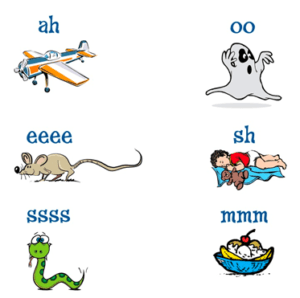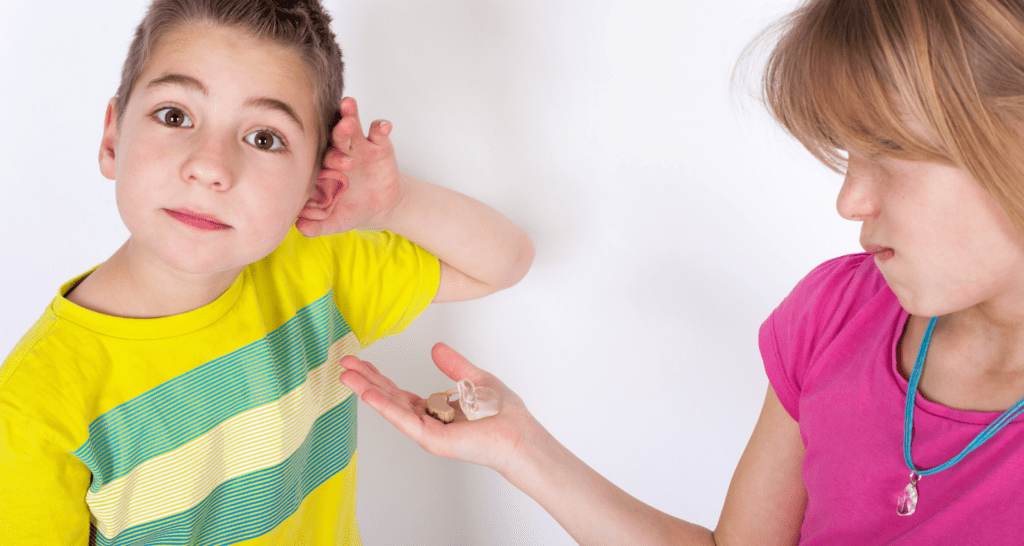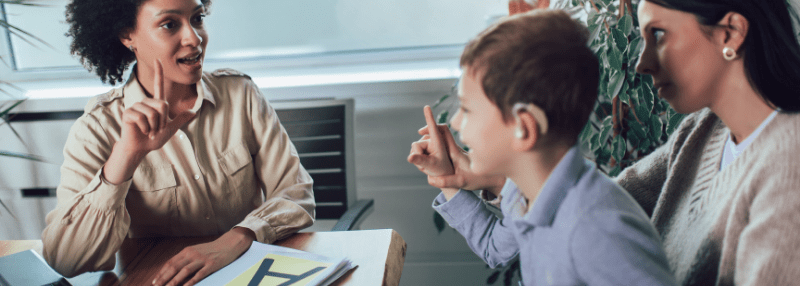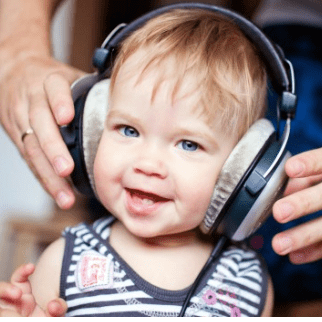Language Developmental milestones, used to evaluate your child’s language as a comparison to their age and peer set, can be very informative to measure where your child lands on this measurement tool. However, all DHH children move through language acquisition on their own timeframe. Language acquisition is a layered process that at times is not beholden to models or age. These milestones are geared to provide general benchmarks and we encourage you to work with your child’s support team as they grow and develop stronger communication skills to maximize your child’s expressive language, receptive language and vocabulary.
Language development is dependent on access to language, whether that is through spoken language or vision, such as American Sign Language (ASL), Cued Language or Total Communication. The path of language development is dependent on accessible, interactive, and abundant language experiences. The sooner a child who is deaf or hard of hearing has exposure to language that meets these criteria, the more likely their language trajectory will mirror the benchmark language development milestones. For many children, enhancing access to auditory language through use of hearing technologies, such as hearing aids, cochlear implants, or bone anchored devices, will often impact language development.


In addition to enhancing communication, early and frequent access to language is also a predictor of how successful a child will be in navigating academics. When your child is deaf or hard of hearing, their hearing levels will impact their access to the world around them and their ability to participate in an educational setting. The key to supporting them in these environments is knowing whether that impact is due to lack of language access or lack of sound access.

For a child who is deaf or hard of hearing, their individual hearing levels significantly impacts their ability to perceive and understand spoken language within the classroom. Even with hearing assistive technology, many children experience fragmented hearing, or only catching bits and pieces of the spoken message. This leads to a “listening gap” which impacts access to and comprehension of information. Children with mild hearing loss can miss out on soft speech, high pitch speech sounds, and unemphasized brief words, leading them to miss out on chunks of the spoken message. This listening gap can also occur with a child who relies on visual supports such as lipreading, or on a visual language, causing them to miss out on critical information.
This listening gap (auditory or visual) leads to increased effort on the part of your child to listen (with ears and/or eyes), process, and understand the spoken message within the classroom. As a result, your child must put forth an increased effort to obtain the message and material being taught. This extra effort to access the content increases the overall cognitive load your child must exert to learn. Because a majority of the effort is placed on simply accessing the message, there is less cognitive load available to learn and retain the material being taught. This leads to a slower learning pace, in which your child may take longer to learn the content.


By now, your child should be able to communicate clearly, and is understood most of the time by familiar adults. Your child understands most of what is said or signed to him or her. Your child is using four to five word sentences, can repeat simple nursery rhymes, and is able to carry on simple conversations.
Taken from https://www.cde.ca.gov/sp/ss/dh/sb210langmilestones.asp
Your child communicates fluently, clearly, and is easily understood by family and familiar adults.
Your child answers questions logically.
Your child uses 4-5 word sentences.
Your child carries on simple conversations staying on topic through 3-4 turns.
Your child talks about things that have happened at school or with friends.
Your child discusses storybooks that are read to him or her.
Your child describes action in pictures.
Your child uses possessives (e.g., mine, yours, his, hers).
Your child is able to repeat a simple signed or spoken rhyme.
Your child makes attempts to read and write.
If using ASL, your child uses classifiers to describe manner, place, direction, size, shape, degree, and intensity.
Your child understands most of what is communicated to them.
Your child understands “Who?”, “What?”, “Where?”, “Why?”, and “How?” questions.
Your child carries out 2-4 simple unrelated successive commands (e.g., Sit down and eat your lunch).
Your child gives you objects as you request them by name.
Your child points to or places objects on top/bottom, up/down at your request.

In general children by this age should be able to use correct sentences to express thoughts about the past, present, and future. By the end of this year, your child should have several thousand words and/signs.
Taken from https://www.cde.ca.gov/sp/ss/dh/sb210langmilestones.asp
Your child signs and/or speaks clearly and fluently in an easy-to-understand manner.
Your child uses long and detailed sentences.
Your child can tell made-up stories that stay on topic. (For ASL users, your child can use space in storytelling.)
For children using spoken language, most sounds are pronounced correctly, though he/she may have difficulty with “r”, “v”, and “th”.
Your child uses rhyming with words and/or signs.
Your child identifies some written letters and numbers.
Your child uses 4-8 word/sign sentences.
Your child uses “has,” “does,” “had.”
Your child uses “because…,” “when…,” “if…,” and “so…, in clauses.
Your child uses “these” and “those.”
Your child uses “before” and “after.”
Your child answers “Why” and “How” questions.
Your child speaks or signs with emotion and body language when describing an event or action.
Your child ends conversations appropriately.
Your child asks “What” questions.
Your child asks “Who” questions.
Your child asks “Where” questions.
Your child asks “Why” questions.
Your child asks “Why do” questions.
Your child uses past tense.
Your child uses future tense.
Your child uses conditional sentences, as in these sentences:
English (If…then…).
ASL (topicalized sentence).
If using ASL, your child uses the five ASL parameters of handshape, palm orientation, location, movement and facial expressions (e.g., button, cat, fox).
In ASL, you child uses number distribution, e.g., talking about leaves falling –
FALL SINGULAR – One leaf falls;
FALL PLURAL- Many leaves fall;
FALL RANDOM – Leaves fall from time to time, here and there.
In ASL, your child repeats Wh- word at beginning and end of question (e.g., WHERE GO WHERE?). This is called WH-bracketing.
In ASL, your child uses the AGENT sign (e.g., FARM-ER; TEACH-ER).
In ASL, your child uses topic continuation (holds a sign with one hand and continues signing with the other).
In ASL, your child uses body shift and eye-gaze.
Your child understands most of what is said or signed at home and in school.
Your child pays attention to short stories.
Your child enjoys stories and can understand simple questions.
Your child carries out four simple related commands in order.
Your child understands things that are similar (e.g., things that fly, things you eat, things you wear).
Your child understands time concepts (e.g., day/night) and seasons of the year.
Your child understands words that rhyme.
Your child points to or places objects before, after, above, below when asked.
Your child uses 2,500+ words and/or signs.
Your child begins to ask the meanings of words and signs.
Your child uses describing words (e.g., hard, soft, yucky).
Your child puts sequencing concepts together (smallest to largest; longest to shortest).
Your child names categories (e.g., pizza, hamburgers as food).
Visit the National Institute on Deafness and Other Communication Disorders (NIDCD)’s page that discusses milestones from 0-5.

While there is information available with benchmarks for 5-6, and it is included below, please note the benchmarks are not specific to deaf or hard of hearing children. Most are related to academics and school learning. Click HERE to see the source list for this section.


Many families utilize ASL as an important communication tool.
Learn about American Sign Language/English as a Second Language (ASL/ESL) or Bilingual/Bicultural (Bi/Bi) on our visual language page through the below link or visit the stages of development page to review the milestones associated with ASL.

We hope you will consider making a gift to support these children. Thank you!
Sign up to be the first to know about new FHSR resources, programs, and events.
FHSR is a qualified 501(C)(3) tax exempt organization. Tax ID number 36-6082810.

FHSR’s MARCOM Gold Award-Winning Website was developed in collaboration with Carlson Integrated, LLC.
MarCom Awards is an international creative competition that recognizes outstanding achievement by marketing and communication professionals. MarCom Awards is administered and judged by the Association of Marketing and Communication Professionals. Judges are industry professionals who look for companies and individuals whose talents exceed a high standard of excellence and whose work serves as a benchmark for the industry. There were over 6,000 entries from 41 countries in the MarCom Awards 2021 competition.